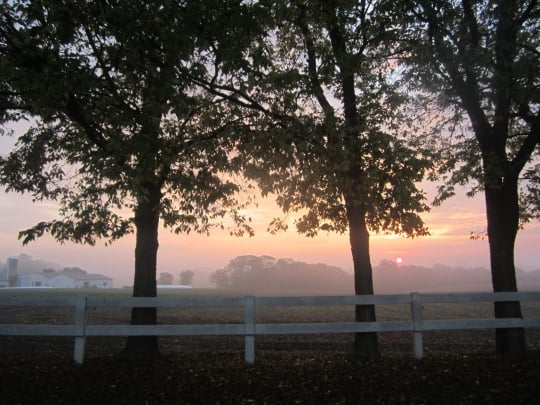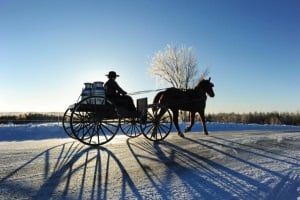The Top 15 States By Amish Population
Which states are home to the most Amish? Here are the top 15 states ordered by how many Amish people live in each. Numbers are based on the 2018 figures from the Young Center.
I’ve grouped the states into 3 tiers below. You’ll also find a brief description of each state’s Amish population. The three figures in parentheses are:
- Number of settlements as of June 2018
- Total number of church districts
- Estimated population
If you’re not familiar with the difference between settlements and church districts, I recommend checking out the two links above.
The Amish continue to grow rapidly and today live in a total of 31 states, 4 Canadian provinces, along with small communities in Bolivia and Argentina.
One caveat – one of the places listed here is not a state at all. That would be the province of Ontario which slots in at #11 on the list.
The 15 States Where You’ll Find The Most Amish – 2018

Tier 1: The Big Three
These three states account for around 2/3 of the entire Amish population. They’re where you’ll find most of the oldest and largest Amish communities. If you’re Amish, there’s a good chance you live in either Pennsylvania, Ohio, or Indiana, home to over 200,000 Amish people.
—
1. Pennsylvania (56 settlements; 514 church districts; 76,620 total Amish) – The Keystone State is the one most associated with the Amish, thanks in large part to Lancaster County, the oldest and biggest individual settlement. Pennsylvania’s total Amish population exceeds the city-limits populations of 16 state capitals, including Bismarck, ND, Charleston, WV, Dover, DE, and Harrisburg, PA.
2. Ohio (62 settlements; 574 church districts; 75,830 Amish) – Ohio has both the most individual communities and church districts and a nearly identical tally of Amish residents as Pennsylvania. Two of the top four Amish settlements by size lie in the Buckeye State (Holmes County and Geauga County).
3. Indiana (24 settlements; 392 churches; 54,825 Amish) – Amish communities span the Hoosier state from top to bottom. Noteworthy are the state’s largest in Lagrange & Elkhart Counties, nearby Nappanee, and the “southernish” Daviess County community. There are also two large Swiss Amish settlements, and two places where you’ll find the grey buggies of Lancaster Amish transplants.

Tier 2: Growing Magnet States
The population totals drop off significantly after the first big three states. But the next five all have sizeable Amish populations of their own. These states have attracted Amish from outside their borders in recent years, often thanks to their having an abundance of areas with relatively lower land prices. All of these states have between 40 and 60 distinct Amish settlements.
—
4. Wisconsin (55 settlements; 160 churches; 21,035 Amish) – It shouldn’t come as a shock that the state with the milk nickname would attract Amish dairy farmers. Since the 1960s Amish have been steadily founding new communities in Wisconsin, and today the state has a half-dozen settlements of at least eight church districts in size.
5. New York (58 settlements; 153 churches; 19,835 Amish) – Over the past 10 years, New York has been the fastest growing of the bunch, with its population nearly doubling in that time. By comparison, the overall Amish population takes around 20 years to double. Land-seeking Amish have purchased and revitalized unused farms in the Empire State.
6. Michigan (48 settlements; 121 churches; 15,465 Amish) – Centreville in St. Joseph County is the oldest and largest community in the state which looks like a mitten. Amish span Michigan from top to bottom, and even have a presence in the beautiful Upper Peninsula.
7. Missouri (46 settlements; 103 churches; 12,860 Amish) – Like several others on this list, MO has also seen a jump in the number of settlements since the turning of the century. Seymour, Jamesport, and Clark are the three big communities in the Show Me State (with Seymour cracking the top 12 largest Amish communities).
8. Kentucky (43 settlements; 95 churches; 12,630 Amish) – Barring the Appalachia region of the state, where relatively few Amish have settled, wherever you might be in Kentucky, you’re not far from a community. Since 2000, the Bluegrass State has seen a spike in interest from Plain settlers – around half of its 40-plus Amish locations have popped up since then.
Tier 3: Grab Bag
This is a mix of states, many of which have either historically longstanding Amish populations, or often one or two individual settlements making up the bulk of the population.
9. Iowa (23 settlements; 67 churches, 9,475 Amish) – The Hawkeye State has 3 settlements of similar size – Kalona, the state’s oldest, Bloomfield, and Buchanan County. Most of the rest of Iowa’s communities are in the 1-3 church district range.
10. Illinois (20 settlements; 57 churches; 7,825 Amish)- Illinois is dominated by the Arthur community, which, like Kalona above, was settled by Amish in the mid-1800s. Arthur contains over half the state’s churches. Most other Amish are clustered in the south and west ends of the Prairie State. Here’s a closer look at two of those small communities, at Ava and Belle Rive/Opdyke.
11. Ontario (16 settlements; 41 churches; 5,120 Amish) – Most Ontario Amish communities were founded since the mid-20th century. Amish moved to Canada in numbers in response to the military draft in the US. There is one settlement which long predates this in-migration. The Milverton community, the state’s largest, was founded in 1824. Amish here keep older dress and buggy customs than others in the province.
12. Minnesota (22 settlements; 38 churches; 4,385 Amish) – The North Star State’s largest community is a Swartzentruber Amish settlement found around the pleasantly-named village of Harmony. Amish here seem to like northern climes; around half the state’s settlements lie in the upper half of the state.
13. Tennessee (12 settlements; 26 churches; 3,220 Amish) – Another state with a Swartzentruber community as its largest (Ethridge). After relatively little interest, Amish settlement here has picked up significantly in recent years, with 2/3 of its communities founded in the past decade. Here’s a look at the state’s second-oldest setttlement, in Carroll County.
14. Kansas (8 settlements; 17 churches; 1,725 Amish) – Kansas has an odd Amish profile – three communities well over a century old, but all remaining small (3 churches or less), with the remaining five communities all created in the past 15 years. Kansas has perhaps the most “Amish” sounding name of any community, at Yoder.
15. Delaware (1 settlement; 10 churches; 1,650 Amish) – The only state on this list whose entire Amish population is found in a single location. Dover Amish have founded several daughter settlements in recent years (here’s one in Virginia). Dover Amish are easily noticed by the group’s distinctive bulky rounded buggy profile.
Bonus: Since I technically promised 15 states here and Ontario squeezed into the list above, the next in line would be Maryland (1,575 Amish), with three settlements of 11 church districts, including the atypical community at Oakland (Garrett County).
Image credit: Buchanan County Amish – djblock99/flickr









Colorado
How many in Colorado? I know of some nearby to me. Thank you.
Colorado numbers
The Young Center study shows 3 settlements, 5 districts, and a total population of roughly 600 Amish in Colorado.
https://groups.etown.edu/amishstudies/statistics/population-2018/
Amish in Maryland
I was wondering how many Amish are in Maryland.
Here’s the Maryland overview if you are interested; it’s a state which has sort of stayed at its 3 settlements with not a lot of new communities being founded: https://amishamerica.com/maryland-amish/